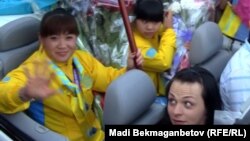
Qishloq Ovozi is pleased to welcome back Matthew Kupfer. In this article, Kupfer takes a look at the recent doping scandal in Kazakhstan and at that country’s efforts to develop national Olympic champions, even when these champions were not originally from Kazakhstan.
On June 15, the International Weightlifting Federation announced that four Olympic weightlifting champions from Kazakhstan had failed tests to detect performance-enhancing drugs carried out on samples taken at the 2012 Summer Olympics in London. The four weightlifters, who all won gold medals in London, have now been provisionally suspended from active competition and will likely be stripped of their medals -- a major blow for Kazakhstan's weightlifting program, which will fall from 12th to 23rd in the medal standings. It is also huge blow for Ilya Ilyin, the men's 94-kilogram gold medalist and a major celebrity in Kazakhstan.
However, the doping revelation also returns us to a controversy surrounding two of the less widely renowned gold medalists: Zulfiya Chinshanlo, who set a new world record in the 53-kilogram weight category of "clean-and-jerk" lifting in 2012, and Maiya Meneza, who set a world record in the 69-kilogram category of the clean and jerk.
In 2012, these two female weightlifters found themselves caught up in an odd scandal when China's Xinhua news agency published an article claiming that Chinshanlo and Maneza were, in fact, born in China. This information contradicted their Olympic biographies and the official story that Chinshanlo and Maneza were Dungans, an ethnic group related to Chinese Hui Muslims, born in Almaty, Kazakhstan, and Bishkek, Kyrgyzstan, respectively.
In July 2012, I published a short investigation into Chinshanlo and Maneza's origins on the Registan.net blog. All the information I found -- video interviews showing the weightlifters speaking fairly basic Russian with a heavy Chinese accent and talking about moving from China to Kazakhstan; an interview with their trainer; and a report on the Kazakh weightlifting program -- suggested that they had indeed been born in China, recruited by the Kazakhstan Weightlifting Federation, granted Kazakh citizenship, and brought to Kazakhstan to train.
The Registan.net post highlighted several interesting aspects of Chinshanlo and Maneza's story: Kazakhstan's deliberate development of its women's weightlifting program, its search for budding champions abroad, and its attempts to develop authentically "Central Asian" champions its population could rally behind. Although the practice of granting citizenship to foreign athletes so they can compete on a country's Olympic team is fairly common, many perceive it as dishonest. Kazakhstan sought to avoid this perception.
While Chinshanlo and Maneza's true ethnic origins remain unclear, their Dungan identity (whether real or fictional) gave their recruitment abroad greater legitimacy. Their trainer, Aleksey Ni, has admitted as much himself.
"We specifically sought out ethnic Dungans, so that their roots would be from Kazakhstan," he said in an interview with Kaspionet.kz.
Despite the controversy about Chinshanlo and Maneza's national origins, their story was compelling. Both were young weightlifters in whom Kazakhstan clearly saw potential when China did not. Thus, whether by birth or by training, I argued on Registan.net, they were very much Kazakhstan's champions.
However, the doping scandal now casts doubt on this story.
Was it Chinshanlo and Maneza's inherent potential and training that won them the gold medals and helped them break two world records or was it simply performance-enhancing drugs?
This is, perhaps, what makes the scandal such a damning blow for Kazakhstan. After investing no shortage of efforts into building a weightlifting team of champions who would have both athletic and "national-cultural" legitimacy, Kazakhstan's cover has been blown. And recruiting athletes abroad -- a sometimes-criticized practice that one Kazakh sports official justified by noting that China didn't train Chinshanlo and Maneza and "let them leave easily" -- now appears especially unsavory.









